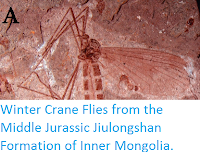Wedge-shaped Beetles, Ripiphoridae, are a small but widely distributed group of Beetles related to Blister and Fungus Beetles. They are unusual in that they are parasitoids, with their larvae developing inside the body of another Insect and only emerging as an adult (typically with fatal consequences for the host), typically targetting Cockroaches, Bees or Wasps (including Wasp species that are themselves parasitoids). Wedge-shaped Beetles lack the penetrating ovipositors (egg laying organs) of parasitoid Wasps, instead laying their eggs on a host or in places where the emergent larvae will encounter a suitable host, for example some Bee-targeting species lay their eggs on flowers, with the newly hatched larvae climbing onto the back of visiting Bees, then hitching a ride back to the hive where they infects larval Bees in their cells. Wedge-shaped Beetles have a limited fossil record, with the majority of fossil species known from Cainozoic amber, and a small number of specimens from Cretaceous amber.
In a paper published in the European Journal of Taxonomy on 14 February 2017, Yun Hsiao of the Department of Entomology at the National Taiwan University and the State Key Laboratory of Biocontrol, Ecology and Evolution at Sun Yat-Sen University, Yali Yu, also of the State Key Laboratory of Biocontrol, Ecology and Evolution at Sun Yat-Sen University and of the College of Life Sciences at Capital Normal University, Congshuang Deng, again of the State Key Laboratory of Biocontrol, Ecology and Evolution at Sun
Yat-Sen University and of the College of Life Sciences at Capital Normal
University and Hong Pang, once again of the State Key Laboratory of Biocontrol, Ecology and Evolution at Sun Yat-Sen University, describe a Wedge-shaped Beetle from the Middle Jurassic Jiulongshan Formation of Inner Mongolia.
The Daohugou Beds of the Jiulongshan Formation are a fossil Lagarstätte
from Ningcheng County in Inner Mongolia, which have produced a large
number of well preserved Middle Jurassic Vertebrates, Insects, Plants
and other fossils. The fauna has been considered to be part of the Jehol
Biota, but is now generally considered to be slightly earlier. The
deposits formed in lake surrounded by a moist, warm-temperate forest,
dominated by Conifers, Ginkos and Cycads.
The new species is named Archaeoripiphorus nuwa, where 'Archaeoripiphorus' is a combination of 'Archaeo' meaning ancient, and 'Ripiphorus' the modern genus from whifh the group gets its name, while 'nuwa' honours the ancient Chinese goddess Nüwa, credited with creating Mankind and rebuilding the world after a terrible flood. The species is described from a single specimen of indeterminate sex, 15.5 mm in length and 5.0 mm in width and covered in fine hairs.
Archaeoripiphorus nuwa. Photograph of complete specimen. Scale bar is 5 mm. Hsiao et al. (2017).
Archaeoripiphorus nuwa cannot be placed in any of the modern subfamilies of the Ripiphoridae, though it does bear some similarities to two modern groups, the Pelecotominae and Ptilophorinae. The similarity to the living Pelecotominae is particularly interesting as the larvae of this group specialise in parasitizing the larvae of Wood-boring Beetles, with the adults laying eggs on infested wood. A number of representatives of Beetle groups with wood-boring larvae today have been found in the Daohugou Biota, combined with Plant fossils which imply a palaeoenvironment with Gymnosperm forests and some Angiosperms.
Reconstruction of Archaeoripiphorus nuwa, illustrating a hypothesized behavior in which the females search for damaged xylem cells, caused by larvae of xylophagous Beetles, to oviposit in wood. Hsiao et al. (2017).
See also...
Follow Sciency Thoughts on Facebook.








